#she was so right in saying this character is a combination of gill and cal
Text




KELLI WILLIAMS in FOUND (1.01)
#kelli williams#found#found nbc#foundedit#margaret reed#mine#kelli williams on my screen in the year of our lord 2023#i can't wait to have my heart ripped out and stomped on#she was so right in saying this character is a combination of gill and cal
49 notes
·
View notes
Text
A SHORT HISTORY OF FEMALE JUDGES IN JUDGE DREDD FROM 2001 TO 2004

As Mega-City One changed leaders at the turn of the 21st Century, so did 2000AD itself, having been bought off Egmont’s hands by independent UK video game developers Rebellion. The early days of this newfound alliance were surprisingly quiet, as Rebellion had never tried their hand at publishing before and the 2000AD editorial team needed time to rebuild and reorganize. So it will take a while for the next giant city-wrecking epic to come by.
In the strip, DeMarco’s departure for the Megazine and Anderson’s continued spinoff success combined with Judge Hershey’s promotion to Chief Judge naturally brought about a sharp increase of the latter’s appearances. But as great as it is to see a character grow into a role in real time, the position does come with a particularly insidious couple of downsides that have plagued her pretty much ever since. More on that later, but for now, let’s get started.
(Previous posts: 1979 to 1982 - 1982 to 1986 - 1986 to 1990 - 1990 to 1993 - 1993 to 1995 - 1995 to 1998 - 1998 to 2001. All stories written by John Wagner unless noted otherwise. “Cover” art by PJ Holden)
Blog favourite Staz Johnson kicks things off drawing “The Sons of Katie Didd” in progs 1248-1249 (June 2001), which features a Judge Vance assisting Dredd with an investigation. She even shows her face too, which was something a bit missing from a lot of background female judges in previous years. Immediately afterwards, we get the last story written by Garth Ennis for the prog, one that would prove divisive with readers even to this day.
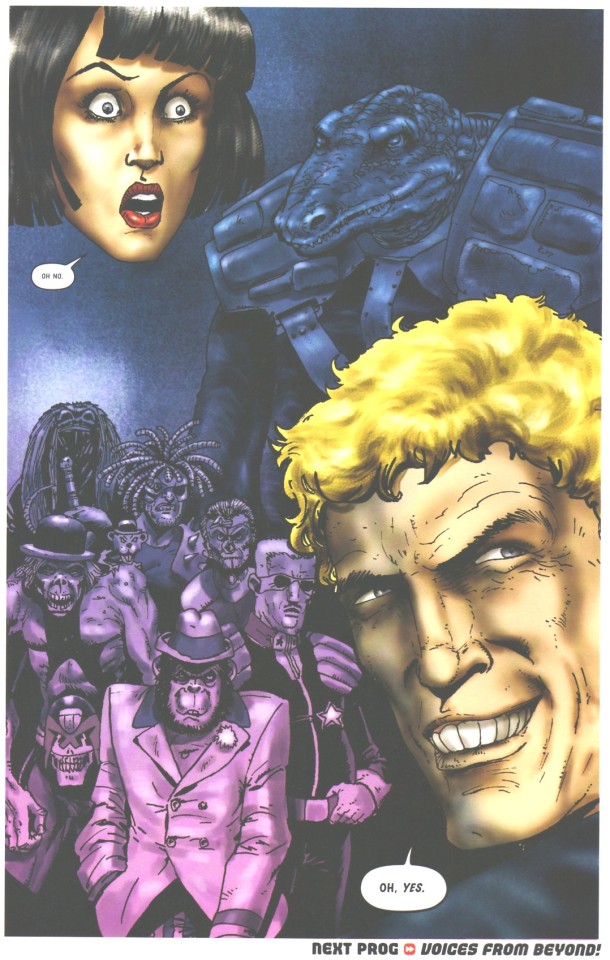
Written as part of a deal to get the rights to his early “Troubled Souls” series back, “Helter Skelter” (drawn by Carlos Ezquerra and Henry Flint, progs 1250-1262, June-September ‘01) is Ennis’ unabashed love letter to all things 2000AD-related, although mostly Dredd. The story concerns a group of scientists who use interdimensional jump technology, reverse-engineered from the Dark Judges’ d-jumps, to send unmanned probes to several alternate universes. However, this catches the attention of one of those universes’ version of Murd the Oppressor, the Necromancer of Necros who’d haunted Dredd and his crew back in the “Judge Child Quest.” This Murd came from a universe where he had succeeded in feeding Dredd to his toad, and upon learning of an alternate reality where Dredd had bested him, travelled across the dimensional gulf to gather a party of many other classic Dredd villains. And together, they came up with a plan to travel back to the main dimension and kill him and take over Mega-City One all over again. It’d seem Ennis had picked up some multiversal habits from working at DC.
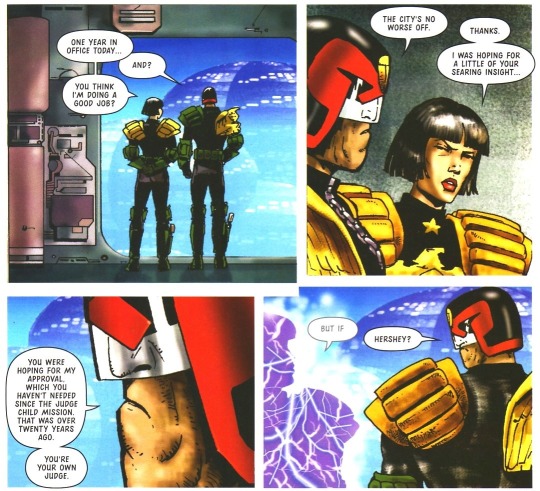
The only female judge in this story is, rather predictably, Chief Judge Hershey. The above panels belong to the second episode, and they do give us a nice, albeit small glimpse into her mindset one year into her first term. It’s interesting to see a bit of uncertainty from her, since right from day one she’s been shown to be fairly comfortable in her role, and Dredd quickly stamps it out by making it clear that she can’t nor should lean on him for approval, even managing to slide in a bit of double meaning with the “You’re your own judge” comment. A harsh, but effective tactic. Perhaps too effective, given what’ll happen a few years from now.
Unfortunately, sharing the same space-time for almost a tenth of a second with an alternate universe Call-Me-Kenneth puts her out of action for most of the story (not to mention leaving her in a rather undignified position), and when she comes back it’s mostly so alt-Judge Cal can have someone to monologue at. We do get a nice little bit of continuity, however, when alt-Fink Angel, whose main universe counterpart had tried to gruesomely murder him back in “The Fink”, calls dibs on her as the rogues gallery tries to decide what to do with the survivors of their initial assault. Ultimately, it’s Murd who wins the discussion, and so we get one Hell of a page:

The sole survivor of Murd’s fun and games, Hershey is nursed back to health by Dredd in a citizen’s apartment and Ennis, perhaps feeling a bit guilty over the whole ordeal, does give her a bit of respect by having Dredd tell her she was “too strong” to die. In all fairness, if there’s one guy who’d know what it takes to survive crucifixion, it’s Ol’ Stoneyface. Unfortunately this is one of those stories that end with Dredd (mostly) single-handedly beating the tar out of everyone else, so there’s not much else for Hershey to do.
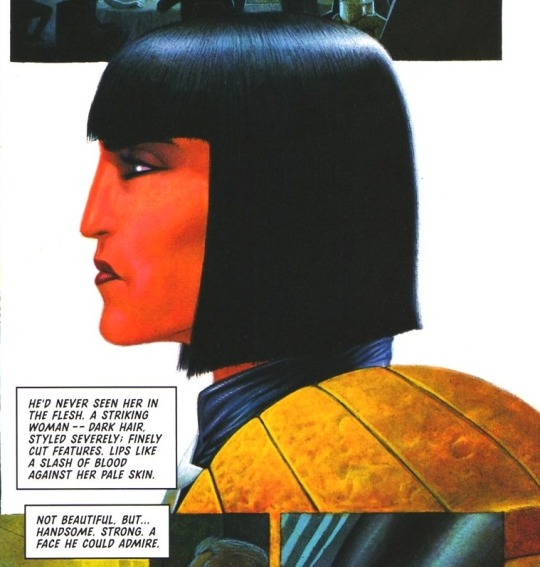
She does take a more center stage in progs 1263-1266′s “On The Chief Judge’s Service” (October ‘01), gorgeously painted by Colin MacNeil. A sequel to “The Chief Judge’s Man”, it opens with Armon Gill, the Justice Killer, seeing Hershey live for the first time in a lecture and then silently murdering a citizen for spreading rumors of her sleeping her way to Chiefdom. Besides showing how much Gill’s obssession has grown, it is interesting to see an outsider’s view of Hershey. We know how citizens feel about judges in general, but opinions on particular judges besides Dredd are much more rare.
Much like in the original there’s not really a lot for Hershey to do in this story, although when Gill is captured as part of a larger plan to kill a previous Justice Killer now languishing in a cube, we do get to see her reaction to being accused of covertly masterminding the murder of dozens of innocents. It’s pretty much what you’d expect from her at this point:
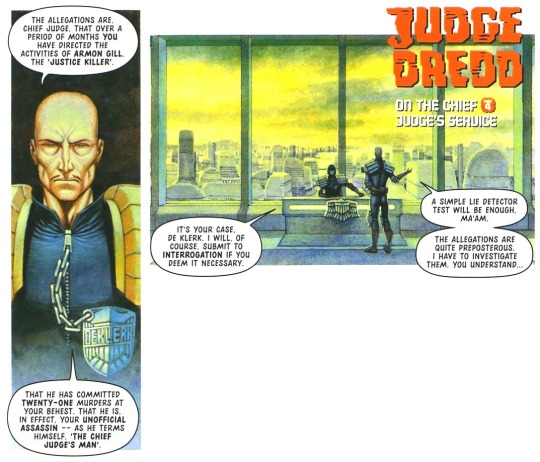
On one hand, this kind of matter-of-fact coolness and honesty are perfectly in line with her character so far, not to mention being admirable qualities in and of themselves. But on the other, this is a good example of Hershey’s biggest problem as a character moving forward: there’s not really a lot of genuine depth to her. She’s certainly an excellent judge, but things like her more liberal views or her relative inexperience, even her underlying lack of desire to be Chief, are just not coming out to the surface. What we’re left with is someone who’s really good at her job, but since so many of Dredd’s stories are based on things going terribly wrong, it’s not a quality that gets showcased a lot. And without McGruder’s conflictive nature, Hershey risks falling into the same bland mold of most Chief Judges before her.
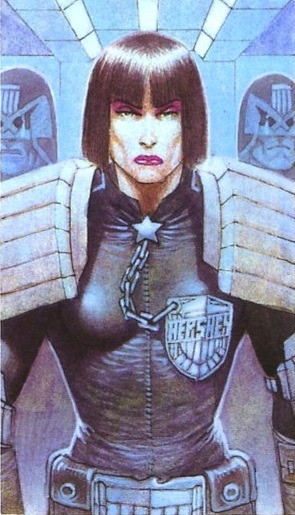
(Slight art error from MacNeil here too: Hershey is wearing the straight shoulderpads and star ornament of Chief Judge, but also her regular badge)
Prog 1271′s “Driving Desire” (December ‘01), by Cliff Robinson introduces Judge Vonne Hollister, a Wally Squad operative under the guise of a slabwalker whom Hershey promotes to the Council of Five as her way of bringing in “the true voice of the streets”. Which is certainly more in tune with how she was portrayed during her candidacy, but as far as this story goes it’s less about any actual lasting developments and more about getting a few laughs from the rather... candid Hollister jokingly trying to tempt her straight-laced colleague, Tek Judge McTighe. A point could be made about Hershey trying to bring more women into the Council, but certainly not by the story itself.
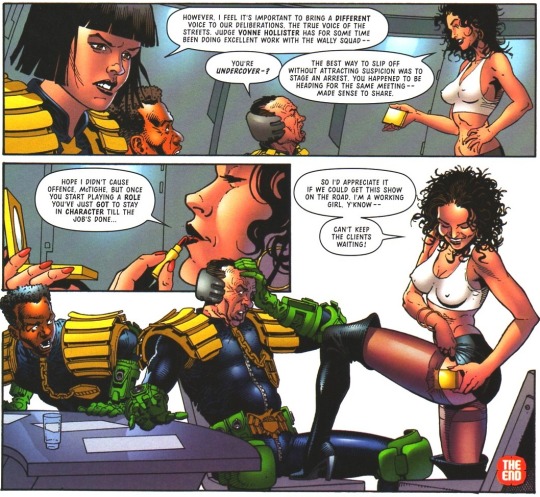
2002 kicks off with prog 1276′s “A Walk in the Park”, written by Gordon Rennie and drawn by Paul Marshall, where Dredd chaperones a group of cadets through a training exercise in one of MC-1′s last surviving parks, among them a girl by the name of Vesey who shows herself to be a bit of a softie, though she hardens up quite quickly. The very next week, we get a small Hershey sighting at the end of prog 1277′s “First Blood”, by Alan Grant and John Burns (February ‘02). Of note is that Dredd calls her by her rank instead of her name, which makes sense since Dredd is always a bit more of a robotic bastard when Grant’s writing him.
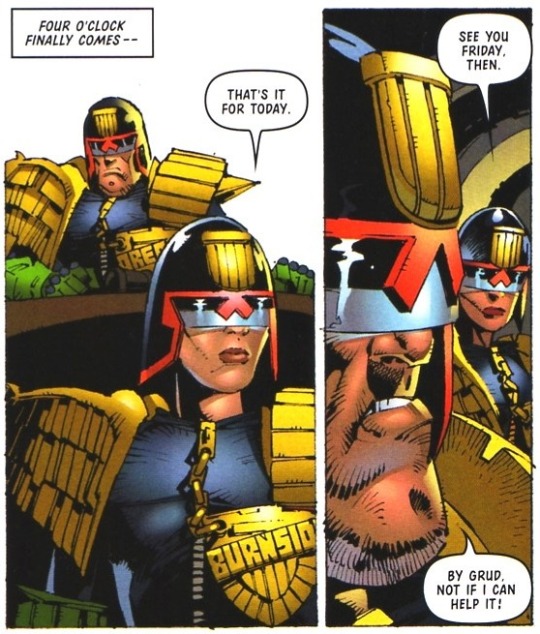
Cam Kennedy makes a double appearance in this post, first by drawing a Judge Ansey helping Dredd deal with the recurring Branch Moronians and their ill-fated hostage-taking attempts in “It’s Deja Vu All Over Again Again” (progs 1282-1283, March ‘02), and later with one of my all-time favorite comedy Dredd strips, “Block Court” (prog 1284), where Judge Burnside helps Dredd get through the soul-crushing horror of old-time due process. There’s also a Brit-Cit judge by the name of Dolman in “Escape from Atlantis” (art by Paul Marshall, progs 1285-1287, April ‘02), although sadly she’s unable to escape getting shot to death by androids.
The next mini-epic is the ten episodes long “Sin City”, drawn by Kev Walker, which ran from prog 1289 to 1299 (May-July ‘02). The eponymous Sin City is a giant floating city that tours the world, allowing visitors to enjoy all manner of illegal activities thanks to its independent sovereignty. Of course, Dredd is not a big fan of this scheme and would rather not see any of his citizens making it their vacation destination of choice, but as it turns out, his boss has other plans. And so, about two years into her first term, we finally get the first of several voice-raising, rank-pulling, table-slamming, “Why are Mommy and Daddy fighting?” rows between Dredd and Hershey:

... which turns out to be pure theater on Hershey’s part to hide the true nature of Dredd’s assignment: an undercover operative in Sin City has reported the presence of an international terrorist with a mad-on for Mega Cities called Ula Danser on the island, and then promptly vanished after trying to get more information. So Hershey wants Dredd on the island to pick up the trail and find out what’s what. This also opens the door for Judge Hollister to reappear, leading a small army of Wally Squad judges into Sin City, including one Judge Molotar who ends up impersonating Ula near the story’s end. There are two other street female judges in the story, Kaplin and Blane, but they don’t really contribute much to it besides filling up crowds (and in Kaplin and Molotar’s case, casualty lists).
Overall there’s not much to say here in regards to our main subject, but Hershey’s penchant for subterfuge and espionage is beginning to show from underneath her liberal cover. She’s clearly gotten used to lying through her teeth and hiding ulterior motives, but she still finds a place in her mind for doubt and regret when Dredd fails to stop a chemical weapon from being released inside Sin City and infecting thousands of citizens, requiring the whole island to be quarantined while the virus runs its course. So we see that Hershey’s lack of ambition doesn’t equate to a lack of standards, and she feels a strong responsibility to do better, which is not something many other chief judges have expressed. At least, not until a major crisis nearly wipes out the entire city.
Moving on, Colin MacNeil returns to paint a couple of background judges in “Blood and Duty” (1300-1301, July ‘02) and Ben Willsher makes his first appearance in these posts by drawing an unnamed med judge at the end of “Case for the Defense” (1303, August ‘02). Ian Gibson returns to draw the Gordon Rennie-written “Give Me Liberty” (1304-1305, idem), another personal favorite comedy story. In it, we get to see Hershey living up to her promise of listening more to the Council, although ultimately it’s Dredd’s suggestion that she follows. And much like McGruder way back in the day, Gibson takes the liberty to redesign the Chief Judge’s badge:

For a bit of variety, we have a vid-fone judge in “Class Project” (art by David Millgate, prog 1310, September ‘02) and an SJS judge by the name of Vickers who conducts a cavity search on a cit mostly for fun and giggles in “Waiting” (by Rennie and PJ Holden, 1312, October ‘02). Carl Critchlow brings out his new artstyle in “Out of the Undercity” (1313-1316, November ‘02) which has Dredd talking to an unnamed female judge who’s wearing a helmet but also the double shoulderpads of a Tek, or even a Chief Judge, so it’s not terribly clear who she is. Another female judge appears as part of a disciplinary council in 1317′s “Reprisal” (art by Paul Marshall, idem) which serves as a small coda to “Sin City.”
While not actually featuring her, prog 1318′s “Open Justice” (by Rennie, Mike Collins and Dylan Teague, idem) deserves an honorary mention for using the framing device of an e-mail sent to Chief Judge Hershey from a disgruntled criminal as part of a new citizen relations idea. Which, in true Justice Dept. fashion, ends up being a total lie.

(After over five years of working in different call centers, this is an intensely relatable page for me)

Having already tango’d with a Predator in the 90s, Dredd finally filled the other side of the intergalactic ugly motherdrokkers dance card in 2003′s “Judge Dredd vs Aliens: Incubus”, written by Wagner and Andy Diggle and drawn by Henry Flint. Starting on the new year’s special and running until April’s prog 1335, the story co-stars Judge Sanchez, a rookie judge fresh out of the academy who is having second doubts about the whole street judge thing, freezes under fire but ultimately manages to find the courage to fight back and help Dredd save the day and... have we been here before? Yeah, Sanchez is pretty much a recycled Castillo, with her character arc condensed into one 15 part storyline. The biggest difference is that Castillo was already a foul-up when we met her, while Sanchez is still teetering on the edge. But apart from that, they may as well be the same character, in all honesty.

The story also has a Judge Pitt who gets her fingers burnt down during the first encounter with the xenomorphs, and of course, Chief Judge Hershey also shows up, mostly just to look really cross as the aliens murder their way through the Grand Hall and to authorize the use of mothballed Mechanismo units, although it was Giant Jr.’s idea. So overall, not much else there either.
A loose end is finally tied in “The Trial of Orlok” (art by Cam Kennedy, progs 1336-1337, April ‘03), which features a Judge Wing as part of a special court that decides the final fate of Orlok the Assassin. No points for guessing what that is. Hollister and Hershey also make small one-panel appearances, although the latter is drawn with regular shoulderpads. A couple of weeks later, Judge Lucas fills a crowd in prog 1339-1341′s “Hard Day’s Night” (May ‘03), written by Robbie Morrison and drawn by Patrick Goddard and Dylan Teague. But going back to loose ends...
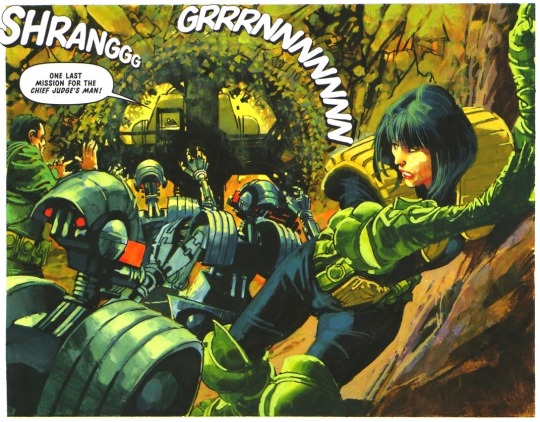
Armon Gill’s third and final outing, “Revenge of the Chief Judge’s Man”, appeared in progs 1342-1349 (May-July 2003) and was drawn by John Burns. It opens with a bit of a surprise return as Dredd visits the Cursed Earth penal colony where Gill is being held to meet with its warden, Judge Jura Edgar, last seen about two years ago when Hershey all but exiled there. To everyone’s surprise, including Edgar’s, Dredd asks her for help in uncovering the identity of the man behind the Chief Judge’s man. And despite being resentful of her demotion, Edgar agrees, half out of curiosity and half out of genuine surprise of Dredd’s humility.
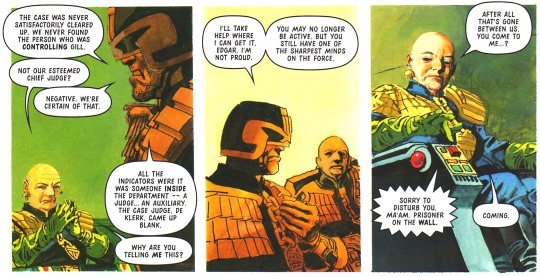
Although brief, Edgar’s role here resembles a more hard-edged Miss Marple, sans the colorful anecdotes. With only a handful of second-hand information to rely on, she accurately produces a psychological profile of Gill’s handler and suggests a couple of possible starting points for Dredd. The narration also gives us a glimpse of Dredd’s own feelings on her, including a lingering regret that it had to come down to this. Even with all that happened there is a strength and dignity to Edgar that he can’t help but respect. But despite her and Dredd’s efforts, Gill manages to escape and sneak his way back into Mega-City One.
Back in the Grand Hall, Dredd tries unsuccessfully to convince Hershey to cut down on official engagements, and although she recognizes the risk, duty comes before security. It’s interesting that, while other Chief Judges would’ve met this threat with a bit of bravado (like the time Griffin held a council meeting on an open terrace, or McGruder herself giving speeches while snipers gunned for her head), Hershey’s reaction is comparatively fatalistic. But out-living three Chiefs while still a member of the Council of Five must really put things in perspective.
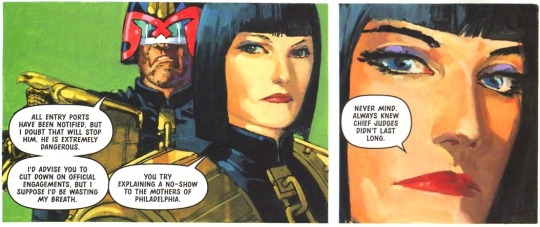
Such fatalism turns out to be 100% justified, as Armon Gill infiltrates an official visit to a tunnel project, commandeers a giant drill and even with three bullets in his chest and Dredd’s fist all over his face, still succeeds in brutally killing the Chief Judge, who dies screaming as she’s shredded to pieces by the deadly machine.
Anyway, our next stop is prog 1360, where--oh wait, hold on, turns out Dredd managed to convince Hershey to use a robot double for once. Overall, there’s not much Chief Judge in the Chief Judge’s Man trilogy. The few snippets of characterization we do get are nothing too insightful or surprising, and by revealing the real face behind Gill in the very first story, it doesn’t even entertain the possibility of Hershey actually being guilty of ordering the murder of innocents. Bit of a missed opportunity there.

“I need a vacation.”
Ok, for real now, our next stop is “See Zammy Run”, by Gordon Rennie and Iñaki Miranda (progs 1360-1361, October ’03), which features a Judge Gulacy, likely named after famed Shang-Chi and Batman artist Paul Gulacy. A week later, Ian Edginton and Steve Pugh introduce us to Judge Jules, a sector house chief with a nasty case of perps dying in lockup, in prog 1363-1364’s “Inside Job” (idem). Hershey returns for a very small cameo at the start of “Meatmonger”, by John Smith and Siku (who had already drawn one of her solo adventures in the Megazine, many winters ago) in progs 1365-1370 (November-December ’03). The first story of the new year, “Cincinnati” (art by Carl Critchlow, progs 1371-1373, January ’04) involves a blind protester assaulting and seemingly seriously wounding the Chief Judge, causing a massive manhunt across the Cursed Earth. And an unnamed female judge assists Dredd in a hostage situation in prog 1374’s “S.A.M.”, (idem) drawn by Val Semeiks and Cliff Robinson.
And then we get to 1375-1377′s “Master of Fear” (February ‘04), written by Alan Grant and drawn by John Burns, which co-stars Psi-Judge Shakta, Anderson’s friend from the Megazine. Or maybe, someone with the same name who looks absolutely nothing like her:
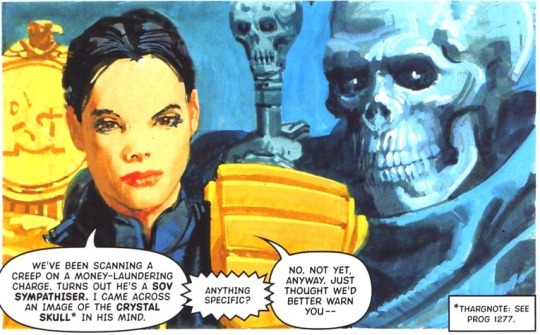
For argument’s sake, here’s Arthur Ranson’s original Shakta:
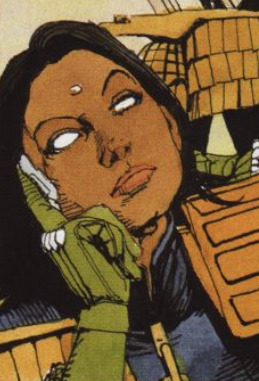
That... is some change. It does seem to have gone mostly unnoticed at the time, probably since people were busy shouting in the Nerve Centre about Steve Moore’s “Valkyries.” To add insult to art error, she doesn’t even get to do much, since Dredd rescues himself in the end.
Moving on, we get a couple of background cadets and a female academy attendant in “Cadets of the Blood” (Ezquerra, progs 1378-1381, March ‘04) and that leaves us comfortably at the start of the last long thrill of this post, prog 1382-1386′s “Gulag”, by Gordon Rennie and Charlie Adlard (April ‘04).
The premise is simple enough: satellite imagery reveals evidence that some Mega-City One judges, likely Apocalypse War prisoners, are being held in a secret sov gulag. A special meeting with Justice Dept’s defense division (two of which are female) is held and a full-on military incursion is dismissed as potentially too harmful to sov relationships. Dredd, who of course is in attendance, is having none of it, and we get a magnificent demonstration of his arm-twisting prowess:
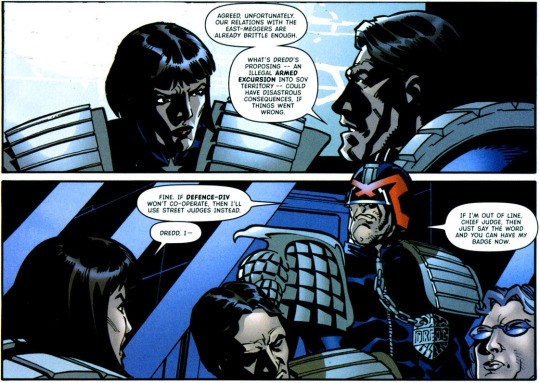
Of course, Hershey is hardly the first Chief Judge to get this particular threat. All the way back in “Robot War” we had Dredd straight-up giving his badge to Goodman and “quitting” until things got hot enough for him to call himself back into action, because deep inside that leathery exterior beats the heart of a total drama queen. Luckily, this time there’s no need for such antics, as Hershey dismisses the council and has a meeting of her own with Dredd that neatly encapsulates everything good and everything bad about their relationship:

By their very positions, Dredd and Hershey see different things. Dredd is all about the small picture, the street level, tiny things that can lead to larger conflicts, and like the street judge he is, his solutions are short and to the point (and usually brutal). Hershey, meanwhile, has to look at the bigger picture. She can't afford anything else. But coming from street division and having worked with him for so long, she understands and agrees with Dredd far more often than her position should. So she gives him what he wants, but also makes sure to establish her own terms as well, which are grounded in her established penchant for subtle, covert operation (although how she expects the sovs to believe MC-1's biggest judge was not acting with the consent of their own department is anyone's guess). Together, they form a two-pronged approach to Mega-City One's affairs, with Dredd keeping an ear on the street and an eye for simple solutions, while Hershey deals with the larger problems and shadier business that Dredd refuses to engage in. And if Dredd sees something that Hershey might have missed, he knows he has a direct line to her, to the highest power in the city who is also sympathetic to his way of thinking.
But that's where the relationship begins to strain: in Dredd's abuse of that closeness, strained by his reckless attempts at arm-twisting. To Dredd, letting nebulous compromises and escalating fears taint his ability to act decisively would be tantamount to treason, and the more the ruling bodies of the department advice caution, the more likely he is to blackmail them into action. And Hershey sees through it immediately. She's not willing to entertain Dredd's antics, but finds herself in the awkward position of agreeing with them. And the more Dredd pushes and oversteps his boundaries trying to strong-arm his own boss into righteous but potentially devastating decisions, the more Hershey feels it. The prongs risk breaking. And while first seen here, this is a conflict that will reapper in various forms and even reach a climax of sorts nearly ten years later.
Going back to “Gulag”, Dredd’s team of volunteers has a fairly respectable female count: Judge Morinta is a med-judge with a taste for modifying weapons that will turn out to be highly valuable on the field, Judge Kleinman is a gruesomely scarred street judge who had already spent four years in one such gulag, and there’s a surprise return in the form of Psi-Judge Karyn making her weekly prog debut. Last seen in the pages of the Megazine, Karyn’s logic for volunteering is, quite frankly, impeccable:
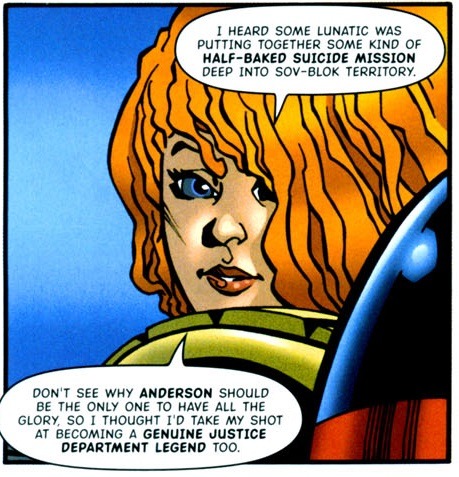
With boots on the snow, Morinta quickly proves her worth by arming everyone with tranq darts to sneak into the camp undetected. Inside, the team finds an empty barrack with the badge numbers for several justice department judges scrawled on the wall, and Karyn confirms Dredd's suspicions by reading the lingering emotions of the people who were kept there. However, they are long gone, moved somewhere else, and everything turns out to be a trap set by War-Marshall Kazan's clone son, Anatoli. Things turn ballistic soon afterwards, and Morinta gets another chance to shine thanks to a special dart with a chemical that blows up spectacularly when in contact with human blood. Karyn also pulls her weight by mind-controlling a sov tank into a bit of friendly fire, and everyone's generally having a pretty good time. Except for Kleinman, who's hit with a tank shell and dies in the battle.
Just when the rest of Dredd's squad seems to be about to end up the same, Justice Dept reinforcements arrive, shoot out the sovs, extract Dredd and company and blow up the entire gulag. All that's left is for Dredd to explain himself to the council, who are worried that his actions will instigate a new apocalypse war. He assures them that the sovs won't do anything, however, since now they have evidence that they kept and still keep Mega-City One judges prisoner decades after all hostilities ceased. Of note here is that Hershey and the council didn't know this and still gave the order to rescue Dredd and his team, so someone up there must've decided that he and his team were worth more than possible nuclear warfare. And although the story doesn't explicitly say so, the most likely source of that order has to be the Chief Judge herself. Especially when, once again, she has a private meeting with Dredd to reveal the mastermind behind the ruse.
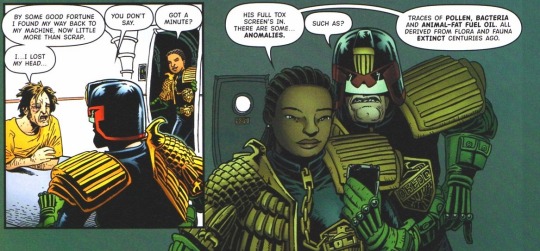
Rounding up the post we have three more small roles: an unnamed black judge harasses a hapless citizen in the hilarious “Finger of Suspicion” (Cam Kennedy, prog 1387, April ‘04). John McCrea draws another female judge in “Last Respects” (written by Gordon Rennie, prog 1389, May ‘04). And in his first appearance on this retrospective, D’Israeli draws another black judge called Lola in the Ian Edginton-written “Tempus Fugitive” (prog 1390, idem). By some coincidence, both the first and the last of this trio have pretty stocky bodytypes, but it’s always nice to get some variety instead of swapped heads on the same body. As for wether said variety will be maintained, we’ll just have to wait and see.
On our next episode: Chief Judge Hershey’s first real crisis goes thermonuclear! And that's just the start of her problems...
#2000AD#Judge Dredd#Female Judges#John Wagner#Garth Ennis#Gordon Rennie#Alan Grant#Carlos Ezquerra#Henry Flint#Colin MacNeil#Cliff Robinson#John Burns#Cam Kennedy#Kev Walker#Ian Gibson#Mike Collins#Dylan Teague#Charlie Adlard#D'Israeli#Chief Judge Hershey#Judge Hershey#Judge Hollister#Judge Sanchez#Judge Edgar#Judge Shakta#Maybe?#Judge Karyn#Judge Lola
16 notes
·
View notes